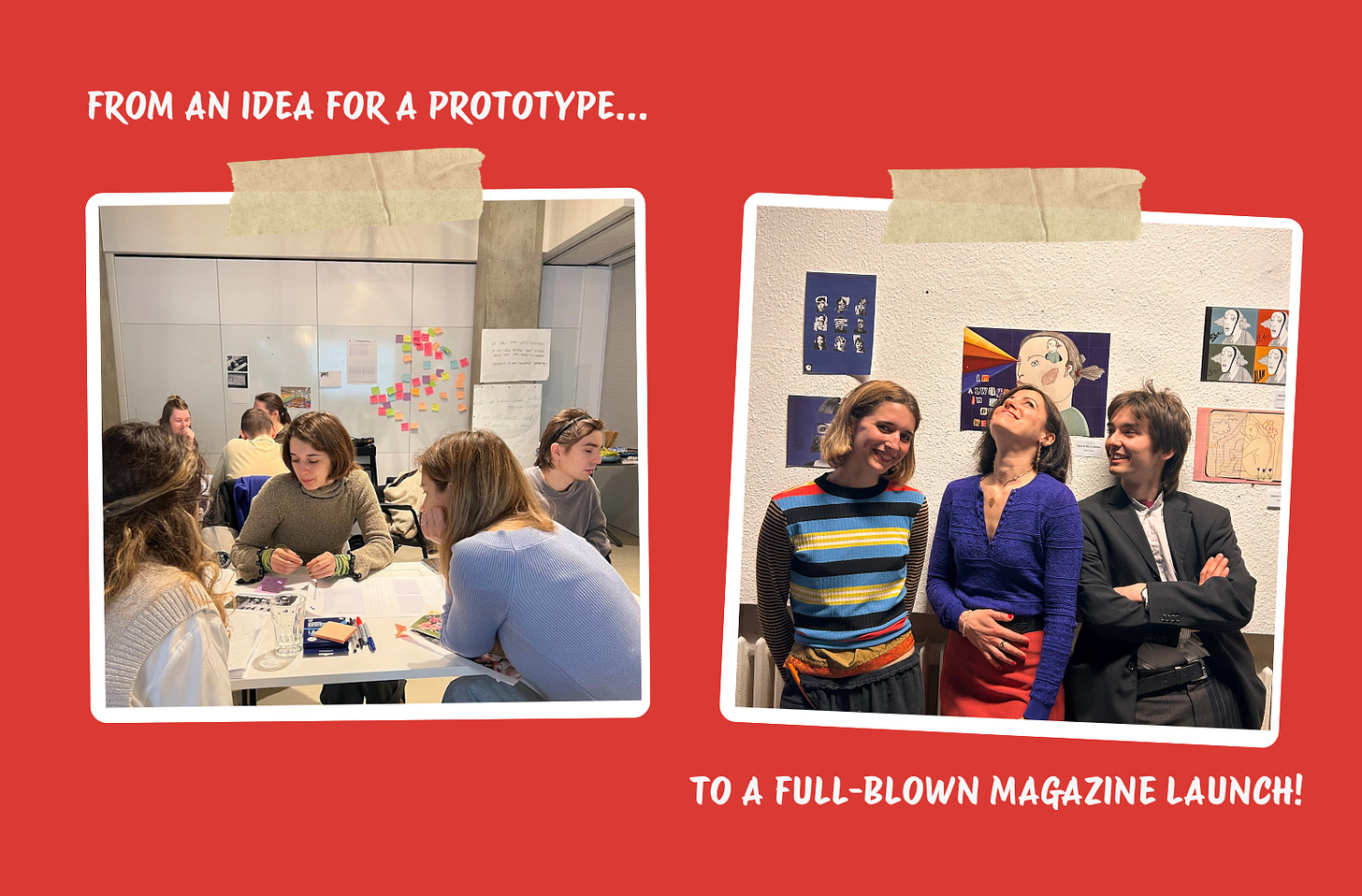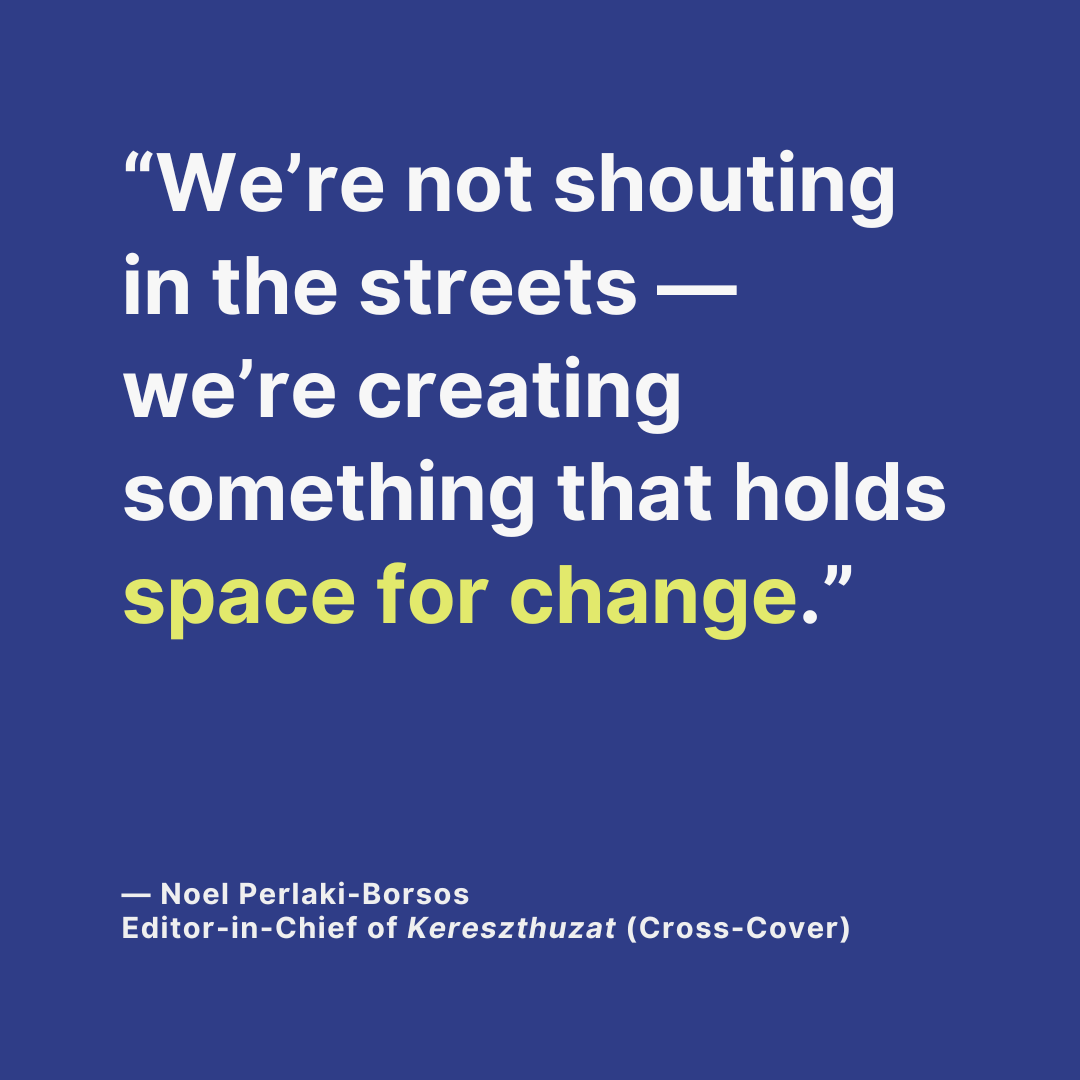💡 What does youth-led media look like in a shrinking democracy?
Learn how a new media collective is shaking up Hungary’s cultural landscape one print issue, public event, and democratic decision at a time...

Welcome back to REWIRE Democracy!
In this final feature spotlighting prototype projects from the REWIRE Democracy Incubator, we’re featuring Cross-Cover (Kereszthuzat): a Hungarian cultural collective and publication run by university students who are using interdisciplinary art and writing to engage their peers in a new kind of civic conversation.
Where Hope Box helped citizens visualize the future, and Impossible Conversations invited activists to reflect inward, Cross-Cover builds outward: offering a physical space, platform, and publication for youth to explore identity, alienation, and belonging in a deeply politicized and often disillusioned context.
At its core, Cross-Cover is a bold experiment in what can happen when art, journalism, and grassroots activism come together, offering plenty of lessons for civil society across Europe and beyond to get inspiration from.
Cross-Cover: A youth-led magazine turning creativity in civic engagement
Cross-Cover (or Kereszthuzat in Hungarian) is a new youth-led cultural collective that uses art, writing, and dialogue to make sense of contemporary issues—and, importantly, to imagine what comes next.
As part of the REWIRE Incubator, creators Róza Szeleczky (Chief Organiser) and Noel Perlaki-Borsos (Editor-in-Chief) developed the Cross-Cover concept through a unique opportunity to receive funding and prototype a new kind of project: one that blends art, civic reflection, and community-building.
Based in Hungary and driven by a rotating team of university students, the project is structured around a print and digital magazine. Each issue explores a different theme (such as alienation, for the first theme) through submissions across genres: essays, short stories, poetry, visual art, sculpture, interviews, and more.
But Cross-Cover isn’t just a magazine. It’s a platform for community. With every new issue, the team organizes live events, including exhibitions, debates, and creative workshops—designed to bring contributors and audiences into shared reflection.
“We want to empower our generation and provide a platform for them to articulate their thoughts in diverse ways, about where our society is and where it should be,” shares the Cross-Cover team.
Print is not dead for these youth activists
Cross-Cover’s creators are students, artists, and writers who noticed something simple but striking: much of the creative work they were producing as part of their studies was staying locked inside files and digital folders.
The magazine became a way to give that work new life: to create a tangible artifact, free to the public, that affirms the value of youth cultural production.
“The magazine format encourages them to slow down and reflect. We believe this has become especially important in today’s sped-up world,” explains Noel. “Not reading or viewing texts and artworks on a small screen lends a sense of ‘realness’ to the subject, it makes it more digestible.”

Rethinking the editorial process
Democracy lives in how we work together. And, unlike most traditional editorial processes, Cross-Cover is democratic by design.
All members of the editorial board—mostly first-year students from Hungary’s liberal and applied arts universities—rotate responsibilities and vote collectively on decisions.
There’s no central editor-in-chief. Instead, there’s a shared belief that co-creation leads to deeper engagement, and that minimizing hierarchy creates more room for joy, ownership, and experimentation.
In Hungary, youth-led civil society platforms are rare—especially ones that are community-driven, non-commercial, and rooted in cultural experimentation.
Cross-Cover is innovating what it means to publish: it's not only rethinking the idea of a magazine, but reimagining it as a vehicle for civic engagement and cultural organizing.

Art, journalism, and activism—all in one
Cross-Cover’s founders were active in student protest movements, but have shifted their approach from protest to platform and community with this project. They have found the importance of making space for conversations and artistic expression key to their movement’s future.
“We’re not shouting in the streets—we’re creating something that holds space for change,” Noel says.
Holding space is its own kind of civic action—especially in societies where youth participation is often undervalued. The team sees their project as creating entry points for deeper engagement through culture, not just campaigns.
As the team explains:
“Cross-Cover is not ‘radical’ (compared to our time in student organisations). That’s part of what makes it feel fresh. We offer, we invite change, we’ve built an uplifting community, we publish, we host inspirational events, and we’re open to anyone who craves our kind of fresh air. We’re simply here, creating space.”

Building a new youth-led media in Hungary
Every article in the first issue contains a forward-looking element, not just pointing out what’s wrong, but offering insight, warmth, and possibility.
This reflects some of the core values of the REWIRE Incubator: hope and creative problem-solving.
“Without REWIRE, we wouldn’t have had the resources to print a high-quality magazine. But more importantly, we wouldn’t have had the chance to reflect so deeply on what we were doing,” explains Noel.
“Through sessions on hope-based communication and narrative framing, the Cross-Cover team learned how to balance [societal] critique with imagination,” the creators say. And imagination is key for building a future that doesn’t reinforce the status quo.

Lessons for civil society
What can civil society learn from a Hungarian youth-led culture collective?
Well, actually, a lot.
Cross-Cover is more than a creative initiative—it’s a civic prototype. It offers a replicable model for how cultural projects can become powerful vehicles for engagement, learning, and collective meaning-making, especially in environments where traditional forms of activism may feel inaccessible or ineffective.
One key takeaway is the importance of format and entry points, lowering the barrier to participation, especially for young people who might be disengaged from formal politics but still deeply care about social issues.
"It’s much easier to engage with young people through culture than directly through politics,” Noel explains. “The themes are often the same, but the format changes everything."
Another lesson is the value of space before strategy. The collective didn’t begin with rigid goals—they started with open-ended invitations: contribute something, show up, reflect.
For civil society looking to do things differently, the team advises: start by observing what your community is missing. Sometimes, what’s needed isn’t a campaign or a protest. Sometimes, it’s space.
Cross-Cover’s non-hierarchical structure, rotating responsibilities, and collaborative decision-making offer a glimpse into how civil society can model the values it promotes.
“We’re interested in what’s happening culturally and politically around us, and how that reflects back in us.”
If we want civic life to be vibrant, inclusive, and future-facing, then we need to invest in platforms like Cross-Cover. And not just as art projects, but as democratic infrastructure.
Ready to think outside the box?
The team behind Cross-Cover welcomes collaboration, adaptation, and exchange with other youth-led movements and art-based groups.
If you’re an educator, organizer, or cultural worker interested in learning more about the Cross-Cover format, learn more and reach out:
Visit the Cross-Cover website at https://www.kereszthuzat.hu/
And remember that together, we can build more platforms that center young voices, community creation, and cross-disciplinary dialogue.
💬 Have you ever built something because you saw that it was missing? How might a project like Cross-Cover look in your city? Let us know in the comments!






